Microstructure Image-Based Finite Element Methodology to Design Abradable Coatings for Aero Engines
Abstract
:1. Introduction
2. Methodology
2.1. Key Performance Design Considerations for Sealing Turbomachinery Using Systems with Abradable Seal Coatings
2.2. Rub Rig Event-Modelling Methodology
2.3. APS Microstructures 1 and 2
2.4. APS Microstructure 3 and 4
2.5. Geometric Modelling of Microstructure
2.6. 3D Modality of Microstructure
2.7. 3D Microstructure Mesh
2.8. FEM Model of Microstructure in LS-DYNA 13.1 Software
2.9. Material Properties for Coating and Blade and Input Parameters for Blade
3. Results
3.1. All Coating Cases—Prior to Erosion Models
3.2. Abradable Seal with 56% Porosity and 48 HR15Y after Erosion Results
3.3. Abradable Seal with 46% Porosity and 71 HR15Y after Erosion Results
3.4. Coatings with the Same Chemical Composition but Different Microstructures (i.e., Porosity and Hardness) May Be Worn Away by Abrasion
3.5. Abradable Seal with 50% Porosity and 55 HR15Y after Erosion Results
3.6. Abradable Seal with 35% Porosity and 77 HR15Y after Erosion
3.7. Coatings with the Same Chemical Composition Might Wear Differently If They Have Various Microstructures, Which in Turn Lead to Varying Porosity and Hardness
3.8. Abradability Comparison Results
3.8.1. Analyses of Coatings’ Abrasion and Erosion Rates
3.8.2. Compatibility of Coatings in Terms of Abradability, Bond Strength, and Rockwell Hardness
3.8.3. Abradability and Wear Depth of Coating Comparison Results
4. Conclusions
Author Contributions
Funding
Data Availability Statement
Conflicts of Interest
References
- Rhys-Jones, T.N. The use of thermally sprayed coatings for compressor and turbine applications in aero engines. Surf. Coat. Technol. 1990, 42, 1–11. [Google Scholar]
- Xiao, J.; Chen, Y.; Chen, D.; Tian, J.; Ouyang, H.; Wang, A. Interactions between blades and abradable coatings: A numerical approach considering geometrical nonlinearity. Int. J. Mech. Sci. 2021, 191, 106052. [Google Scholar]
- Cheng, X.; Yu, Y.; Zhang, D.; Liu, T.; Liu, J.; Shen, J. Preparation and performance of an abradable NiCrFeAlBN-YSZ-NiCrAl layered seal coating for aircraft engines. J. Therm. Spray Technol. 2020, 29, 1804–1814. [Google Scholar]
- Ma, X.; Matthews, A. Evaluation of abradable seal coating mechanical properties. Wear 2009, 267, 1501–1510. [Google Scholar]
- Faraoun, H.I.; Grosdidier, T.; Seichepine, J.L.; Goran, D.; Aourag, H.; Coddet, C.; Zwick, J.; Hopkins, N. Improvement of thermally sprayed abradable coating by microstructure control. Surf. Coat. Technol. 2006, 201, 2303–2312. [Google Scholar]
- Johnston, R.E. Mechanical characterisation of AlSi-hBN, NiCrAl-Bentonite, and NiCrAl-Bentonite-hBN freestanding abradable coatings. Surf. Coat. Technol. 2011, 205, 3268–3273. [Google Scholar]
- Padture, N.P.; Gell, M.; Jordan, E.H. Thermal barrier coatings for gas-turbine engine applications. Science 2002, 296, 280–284. [Google Scholar]
- Carter, T.J. Common failures in gas turbine blades. Eng. Fail. Anal. 2005, 12, 237–247. [Google Scholar] [CrossRef]
- Aussavy, D.; Bolot, R.; Peyraut, F.; Montavon, G.; Selezneff, S. Thermomechanical Properties of CoNiCrAlY-BN-Polyester Composite Coatings Elaborated by Atmospheric Plasma Spraying. Key Eng. Mater. 2014, 606, 167–170. [Google Scholar]
- Hou, X.; Liu, Z.; Wang, B.; Lv, W.; Liang, X.; Hua, Y. Stress-strain curves and modified material constitutive model for Ti-6Al-4V over the wide ranges of strain rate and temperature. Materials 2018, 11, 938. [Google Scholar] [CrossRef]
- Liu, J.; Yu, Y.; Liu, T.; Cheng, X.; Shen, J.; Li, C. The influence of composition and microstructure on the abradability of aluminum-based abradable coatings. J. Therm. Spray Technol. 2017, 26, 1095–1103. [Google Scholar]
- Faraoun, H.I.; Seichepine, J.L.; Coddet, C.; Aourag, H.; Zwick, J.; Hopkins, N.; Sporer, D.; Hertter, M. Modelling route for abradable coatings. Surf. Coat. Technol. 2006, 200, 6578–6582. [Google Scholar]
- Klusemann, B.; Hortig, C.; Svendsen, B. Modeling and simulation of the microstructural behaviour in thermal sprayed coatings. In PAMM: Proceedings in Applied Mathematics and Mechanics; Wiley Online Library: Hoboken, NJ, USA, 2009; pp. 421–422. [Google Scholar]
- Bolelli, G.; Candeli, A.; Koivuluoto, H.; Lusvarghi, L.; Manfredini, T.; Vuoristo, P. Microstructure-based thermo-mechanical modelling of thermal spray coatings. Mater. Des. 2015, 73, 20–34. [Google Scholar]
- Nayebpashaee, N.; Seyedein, S.H.; Aboutalebi, M.R.; Sarpoolaky, H.; Hadavi, S.M.M. Finite element simulation of residual stress and failure mechanism in plasma sprayed thermal barrier coatings using actual microstructure as the representative volume. Surf. Coat. Technol. 2016, 291, 103–114. [Google Scholar]
- Klusemann, B.; Denzer, R.; Svendsen, B. Microstructure-based modeling of residual stresses in WC-12Co-sprayed coatings. J. Therm. Spray Technol. 2012, 21, 96–107. [Google Scholar]
- Taylor, T.A.; Thompson, B.W.; Aton, W. High speed rub wear mechanism in IN-718 vs. NiCrAl–Bentonite. Surf. Coat. Technol. 2007, 202, 698–703. [Google Scholar]
- Murugan, M.; Ghoshal, A.; Walock, M.; Nieto, A.; Bravo, L.; Barnett, B.; Pepi, M.; Swab, J.; Pegg, R.T.; Rowe, C.; et al. Microstructure based material-sand particulate interactions and assessment of coatings for high temperature turbine blades. In Turbo Expo: Power for Land, Sea, and Air; American Society of Mechanical Engineers: New York, NY, USA, 2017; p. V02DT48A009. [Google Scholar]
- Sharma, A.; Vijay, A.; Sadeghi, F. Finite element modeling of fretting wear in anisotropic composite coatings: Application to HVOF Cr3C2–NiCr coating. Tribol. Int. 2021, 155, 106765. [Google Scholar]
- Holmberg, K.; Laukkanen, A.; Ghabchi, A.; Rombouts, M.; Turunen, E.; Waudby, R.; Suhonen, T.; Valtonen, K.; Sarlin, E. Computational modelling based wear resistance analysis of thick composite coatings. Tribol. Int. 2014, 72, 13–30. [Google Scholar]
- Zemlianov, A.; Balokhonov, R.; Romanova, V.; Gatiyatullina, D. The influence of bi-layer metal-matrix composite coating on the strength of the coated material. Procedia Struct. Integr. 2022, 35, 181–187. [Google Scholar]
- Balokhonov, R.; Romanova, V.; Kulkov, A. Microstructure-based analysis of deformation and fracture in metal-matrix composite materials. Eng. Fail. Anal. 2020, 110, 104412. [Google Scholar]
- Hu, Z.-C.; Liu, B.; Wang, L.; Cui, Y.H.; Wang, Y.W.; Ma, Y.D.; Sun, W.W.; Yang, Y. Research progress of failure mechanism of thermal barrier coatings at high temperature via finite element method. Coatings 2020, 10, 732. [Google Scholar]
- Li, C.-J.; Zou, J.; Huo, H.-B.; Yao, J.-T.; Yang, G.-J. Microstructure and properties of porous abradable alumina coatings flame-sprayed with semi-molten particles. J. Therm. Spray Technol. 2016, 25, 264–272. [Google Scholar]
- Duramou, Y.; Bolot, R.; Seichepine, J.L.; Danlos, Y.; Bertrand, P.; Montavon, G.; Selezneff, S. Relationships between microstructural and mechanical properties of plasma sprayed AlSi-Polyester composite coatings: Application to abradable materials. Key Eng. Mater. 2014, 606, 155–158. [Google Scholar]
- Berthoul, B.; Batailly, A.; Stainier, L.; Legrand, M.; Cartraud, P. Phenomenological modeling of abradable wear in turbomachines. Mech. Syst. Signal Process. 2018, 98, 770–785. [Google Scholar]
- Nyssen, F.; Batailly, A. Thermo-mechanical modeling of abradable coating wear in aircraft engines. J. Eng. Gas Turbines Power 2019, 141, 021031. [Google Scholar]
- Azarmi, F.; Chen, X.; Cizek, J.; Cojocaru, C.; Jodoin, B.; Koivuluoto, H.; Lau, Y.; Fernandez, R.; Ozdemir, O.; Jazi, H.S.; et al. Contribution in Optimization of Abradable Honeycomb Seal Structure. Thermal Spray-International Thermal Spray Conference Proceedings, Paper no itsc2021p0031, 2021, pp. 31–35. Available online: https://www.researchgate.net/profile/Dmitry-Dzhurinskiy/publication/352483032_Contribution_in_Optimization_of_Honeycomb_Abradable_Seals_Structure/links/60cdb06092851ca3acaf85d9/Contribution-in-Optimization-of-Honeycomb-Abradable-Seals-Structure.pdf (accessed on 18 August 2023).
- Ni, Y.; Zhang, F.; Njoku, D.I.; Yu, Y.; Pan, J.; Meng, M.; Li, Y. Corrosion mechanism of CuAl-NiC abradable seal coating system—The influence of porosity, multiphase, and multilayer structure on the corrosion failure. J. Mater. Sci. Technol. 2021, 88, 258–269. [Google Scholar]
- Irissou, E.; Dadouche, A.; Lima, R.S. Tribological characterization of plasma-sprayed CoNiCrAlY-BN abradable coatings. J. Therm. Spray Technol. 2014, 23, 252–261. [Google Scholar]
- Aussavy, D. Processing Characterization and Modeling of Thermomechanical Properties of Threee Abradable Coatings: NiCrAl-Bentonite, CoNiCrAlY-BN-Polyester, and YSZ-Polyester. Ph.D. Dissertation, Université de Technologie de Belfort-Montbeliard, Belfort, France, 2016. [Google Scholar]
- Pereira, C.B.; He, Q.; Soares, P.; Meruvia, M.S.; de Souza, G.B.; Amorim, F.L.; De Paiva, J.M.; Veldhuis, S.C.; Torres, R.D. Tribological characterization of PVD TiSiN/AlCrN coating: A comprehensive study on thermal effect. Mater. Charact. 2023, 203, 113135. [Google Scholar]
- Jadhav, P. Abradable coatings: Design through microstructure based models. Mater. Today Proc. 2022, 62, 7353–7357. [Google Scholar]
- Pan, S.; Jin, K.; Wang, T.; Zhang, Z.; Zheng, L.; Umehara, N. Metal matrix nanocomposites in tribology: Manufacturing, performance, and mechanisms. Friction 2022, 10, 1–39. [Google Scholar]
- Prashar, G.; Vasudev, H.; Thakur, L. Performance of different coating materials against slurry erosion failure in hydrodynamic turbines: A review. Eng. Fail. Anal. 2020, 115, 104622. [Google Scholar]
- Hallquist, J.O. LS-DYNA® Keyword User’s Manual Volume I; Livermore Software Technology Corporation: Livermore, CA, USA, 2009. [Google Scholar]
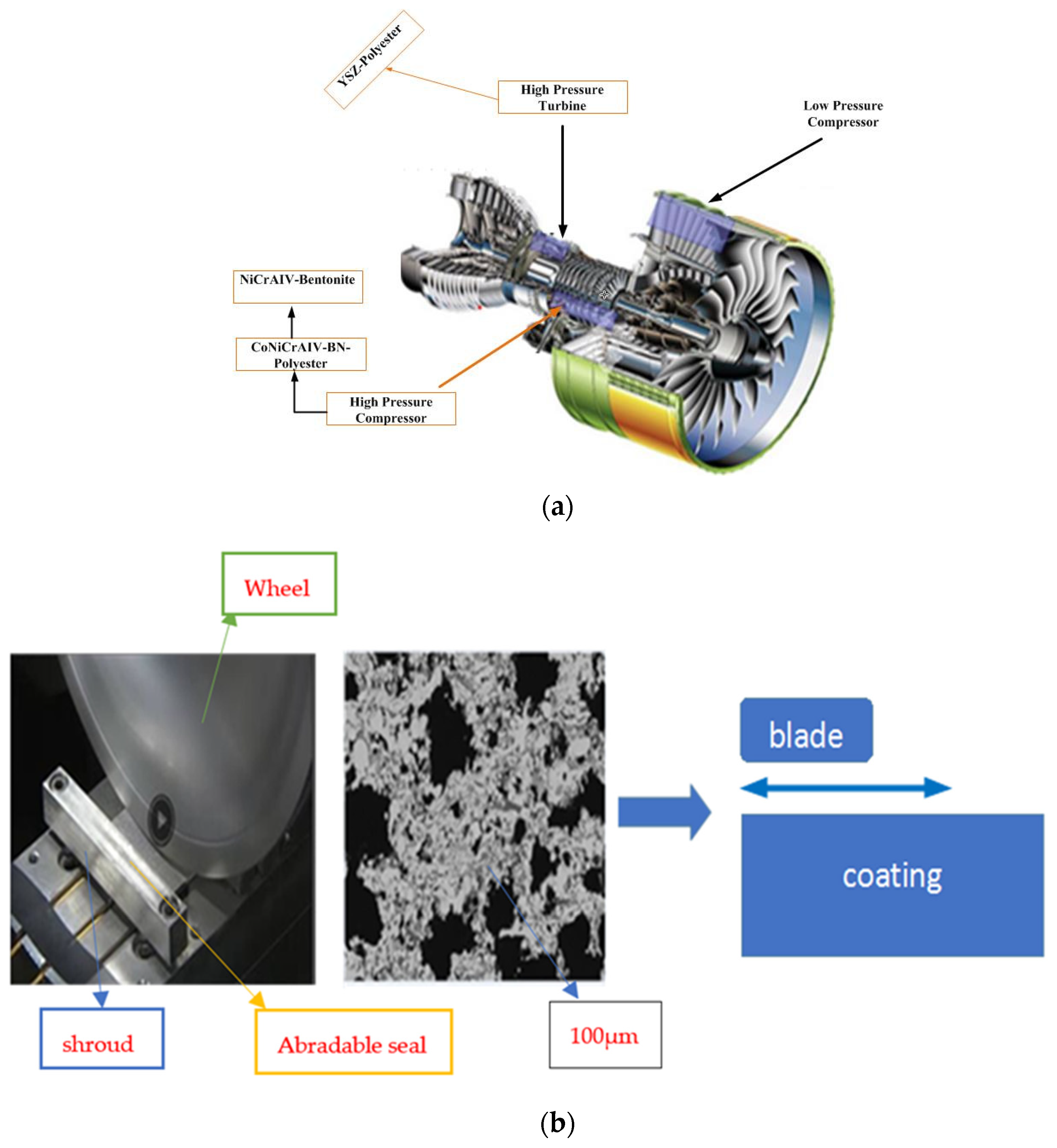
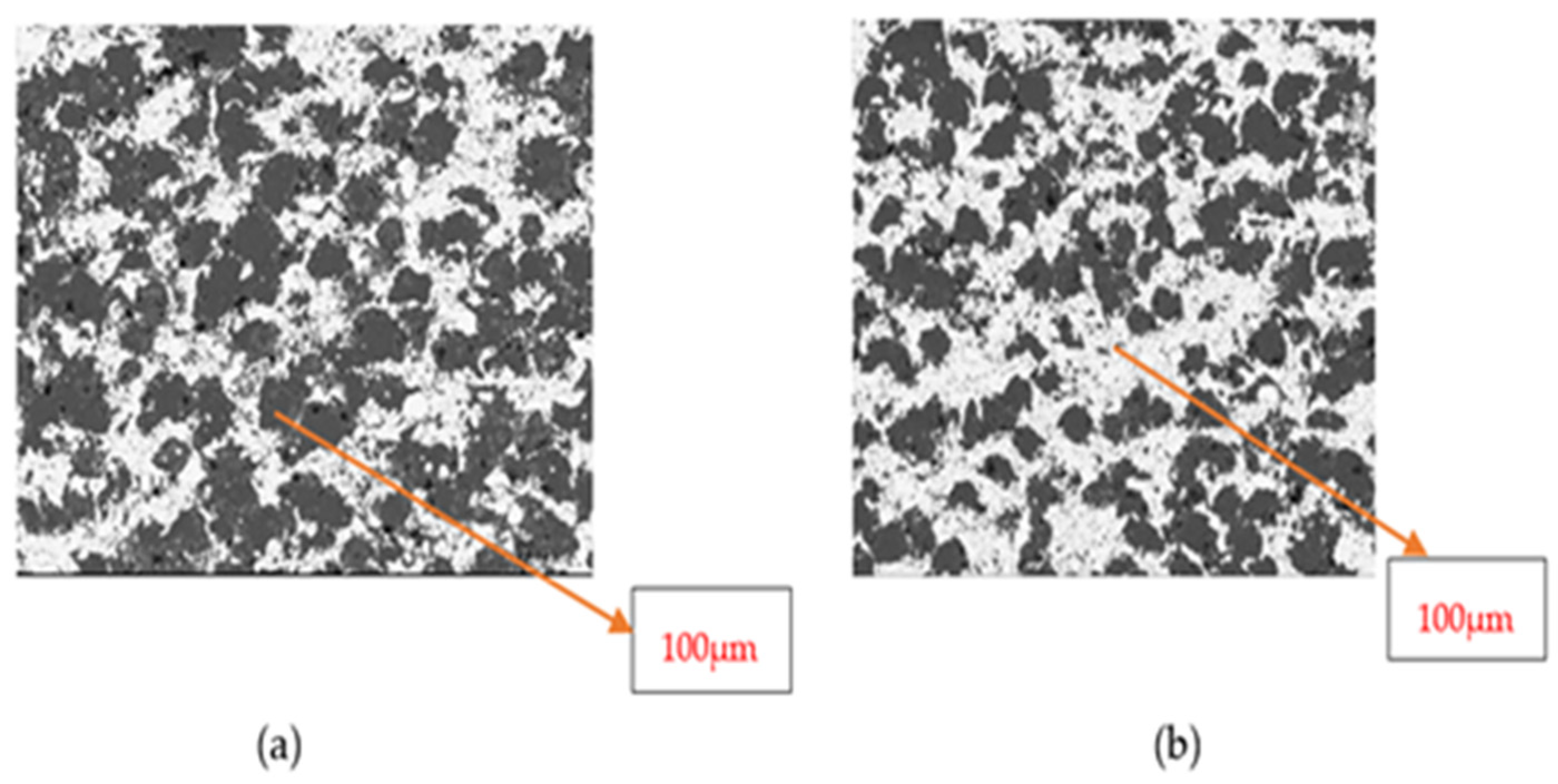
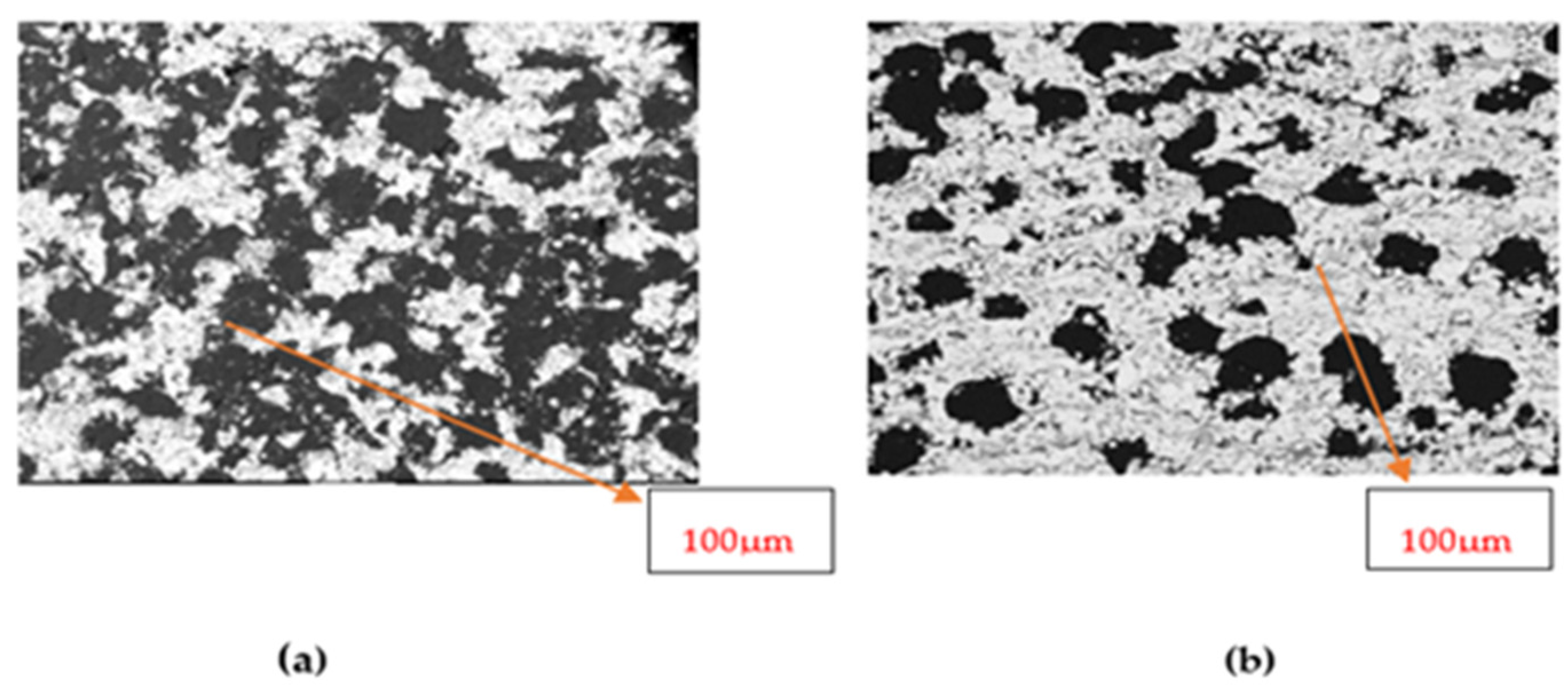

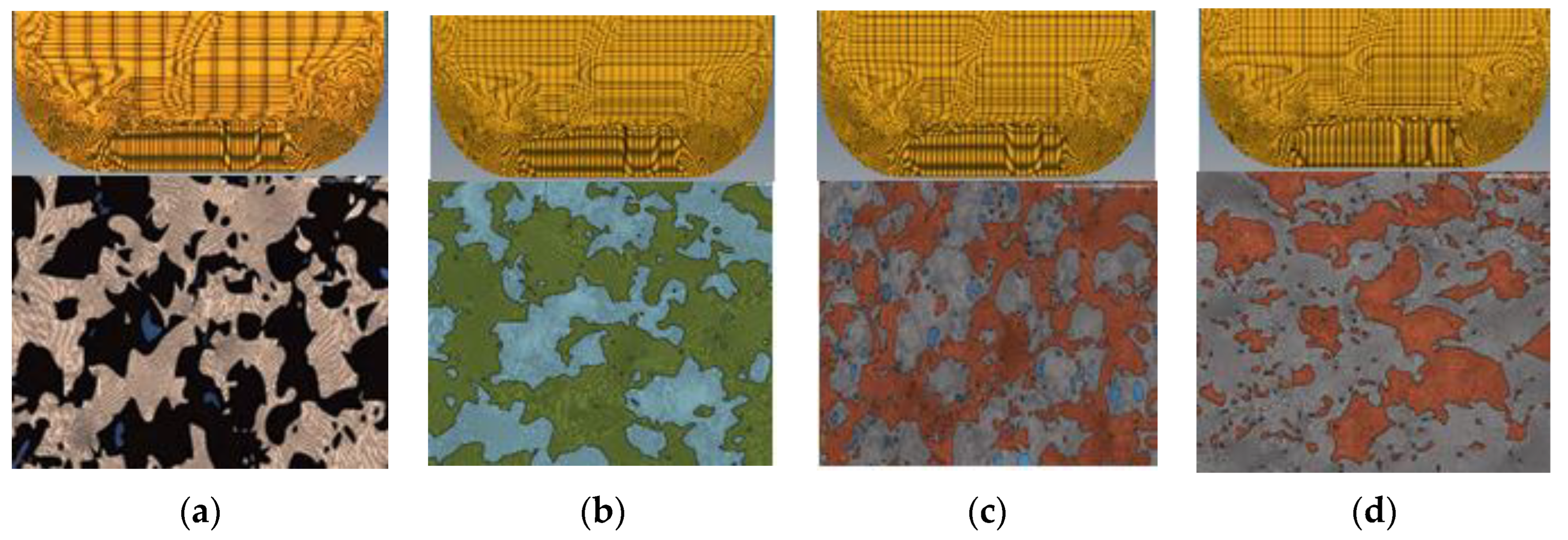
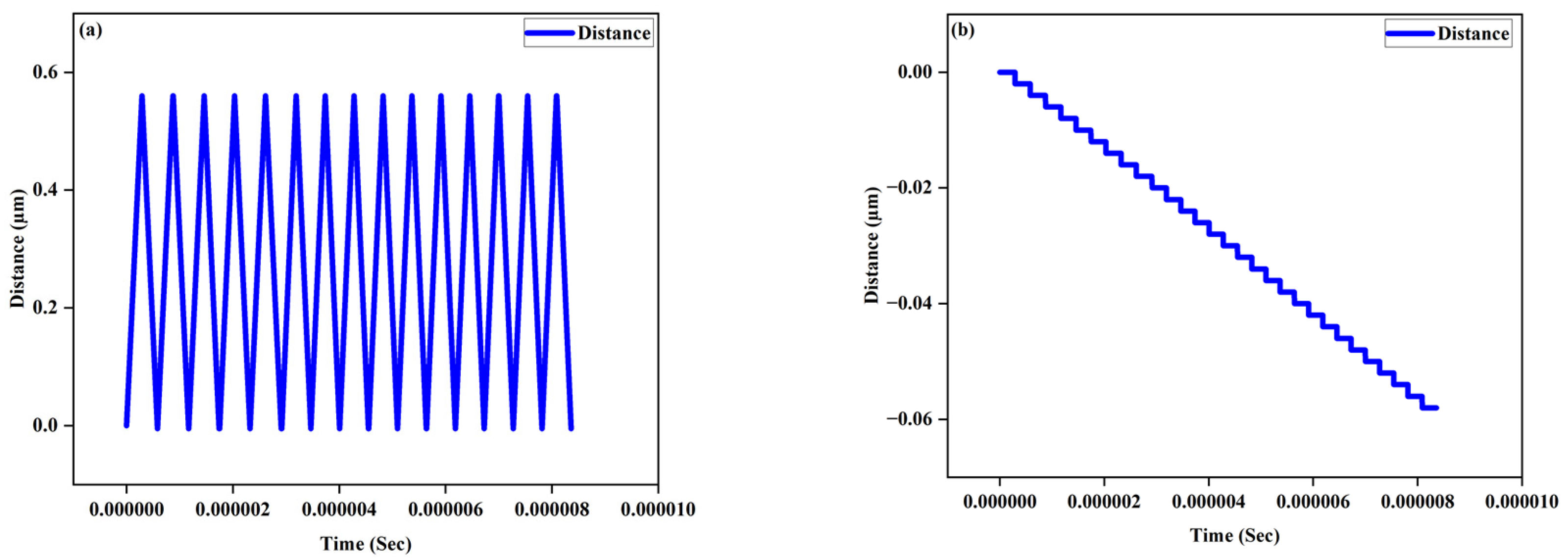
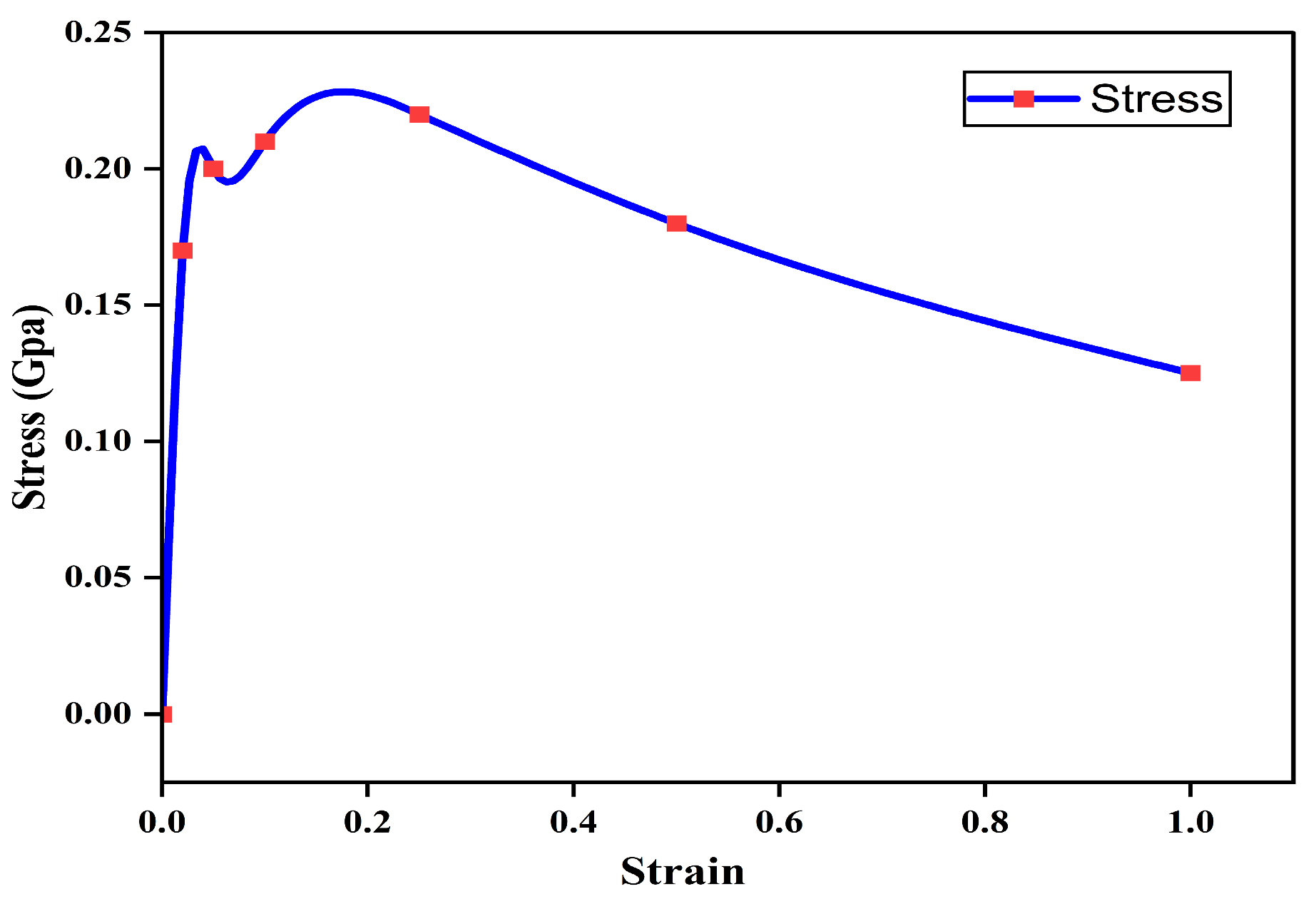



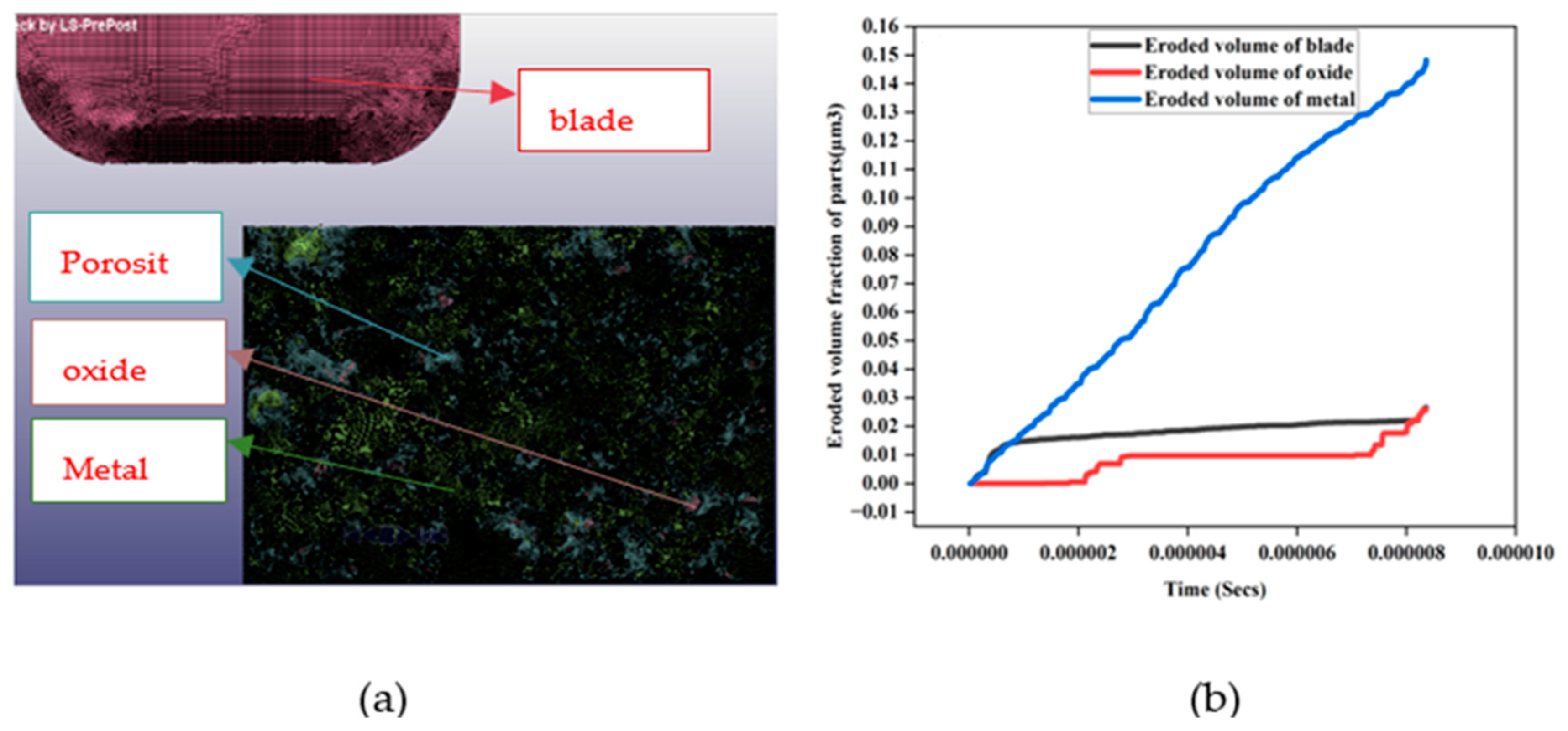
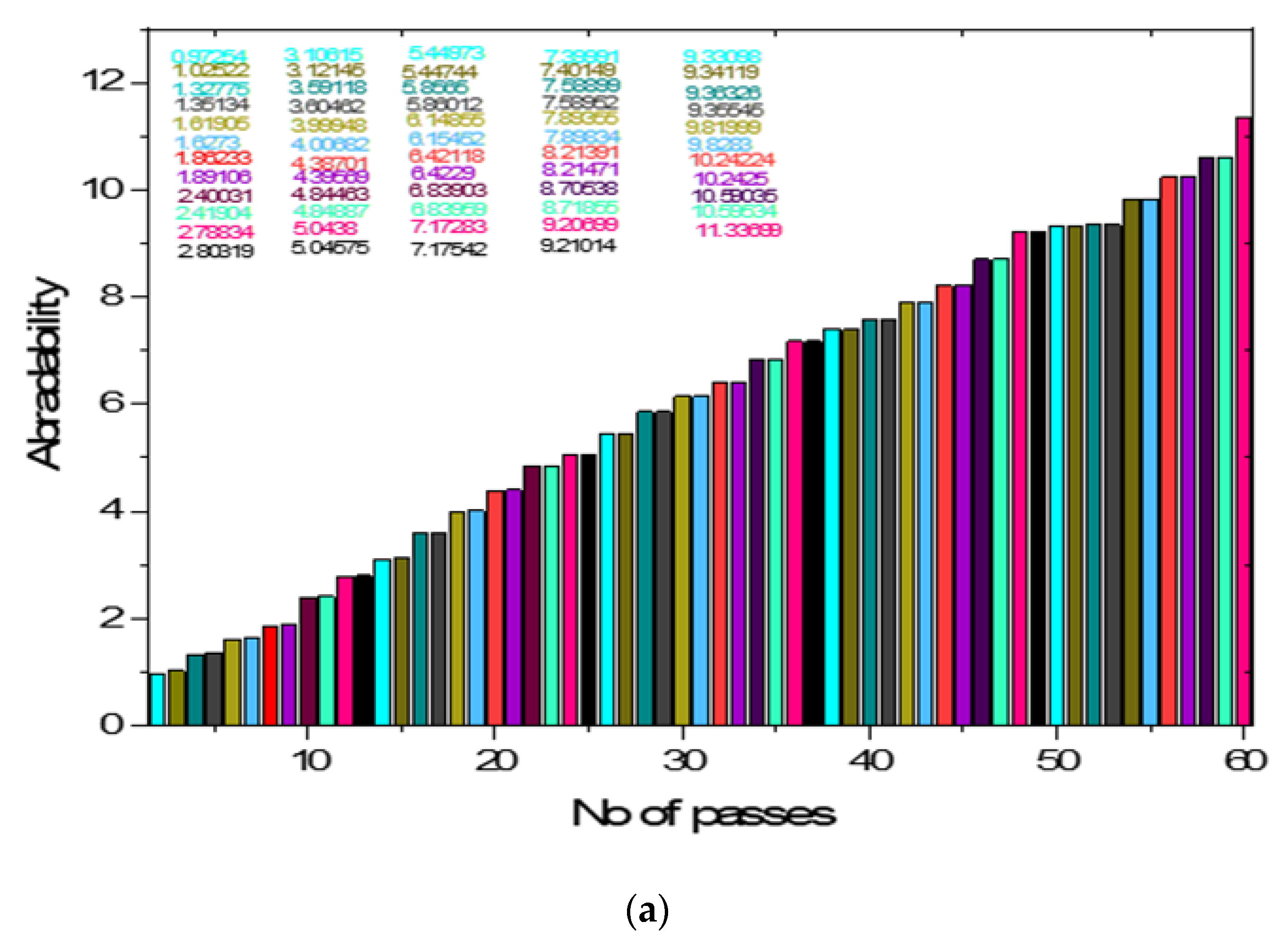
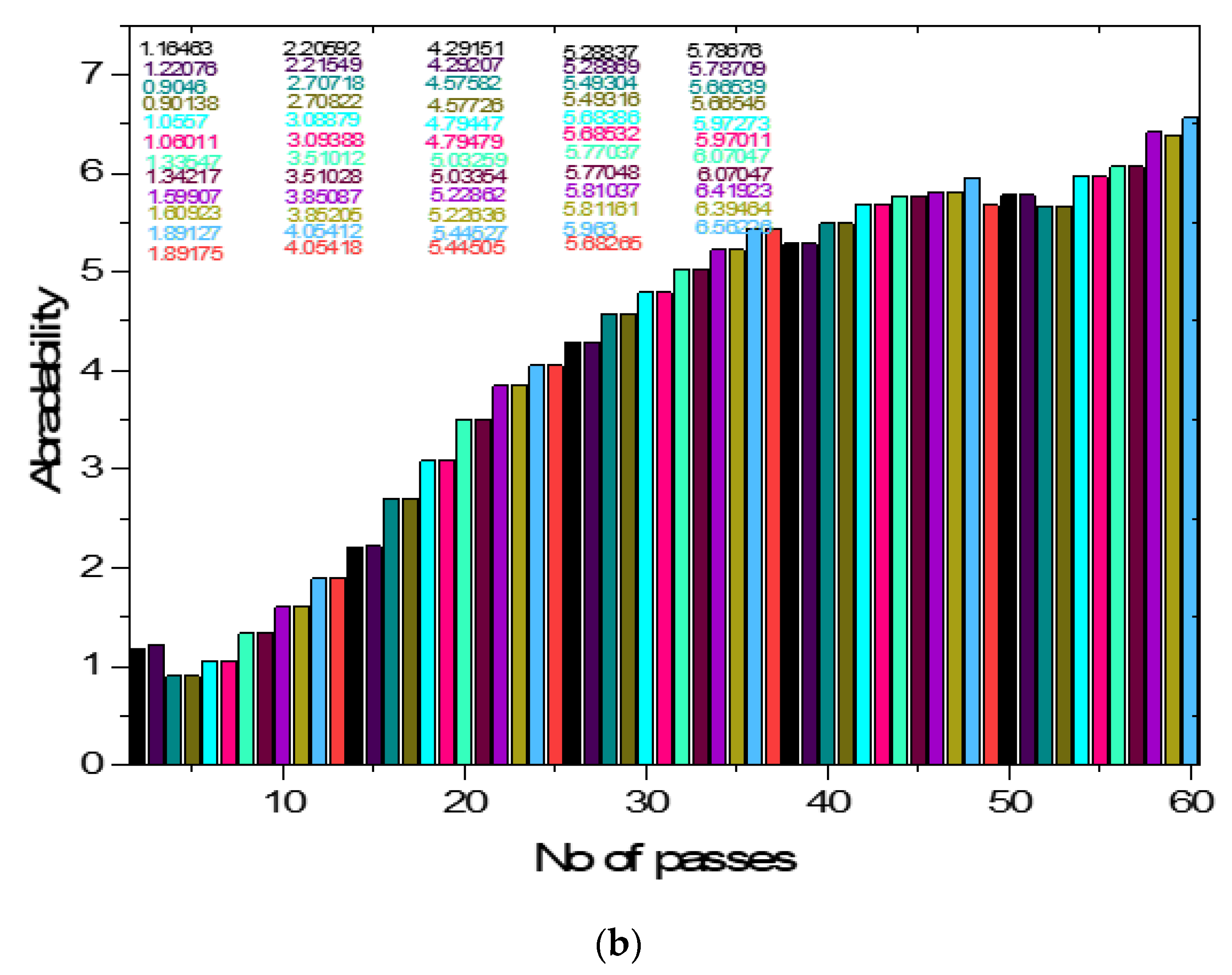
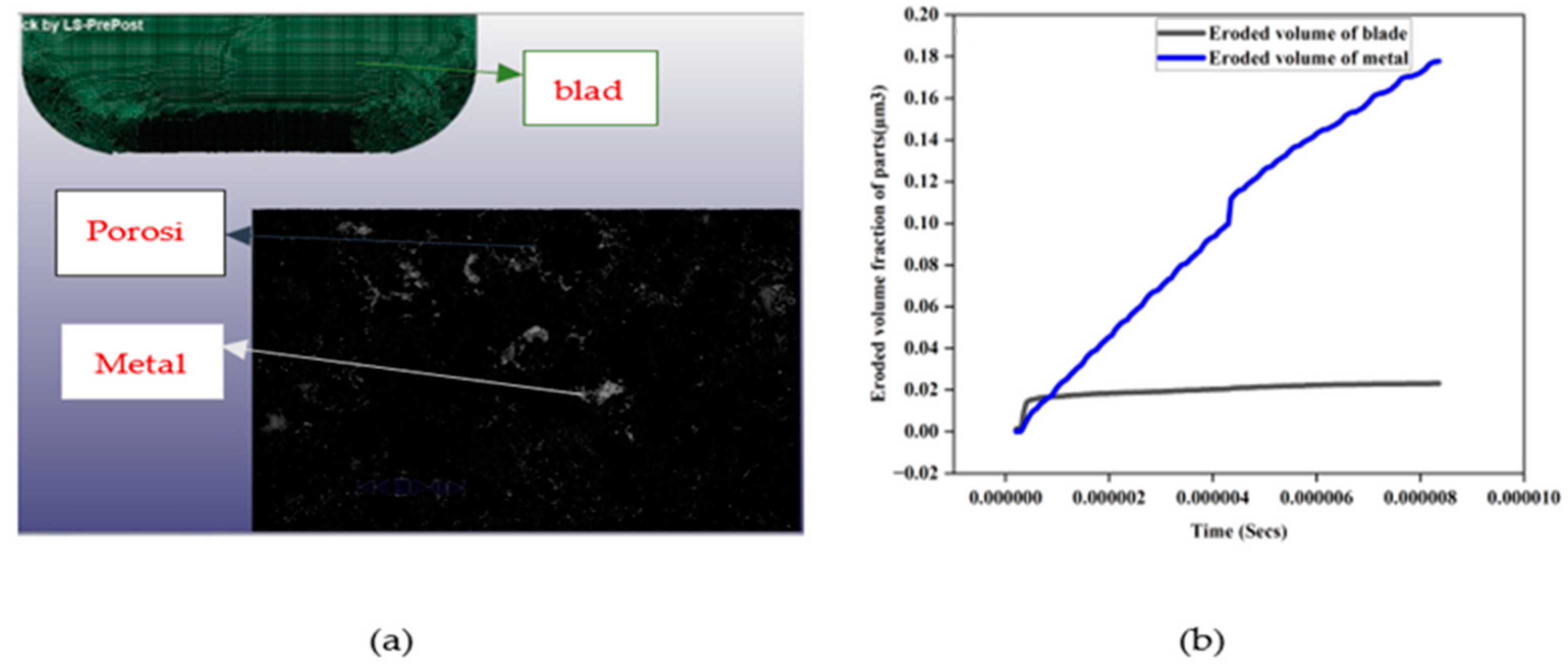
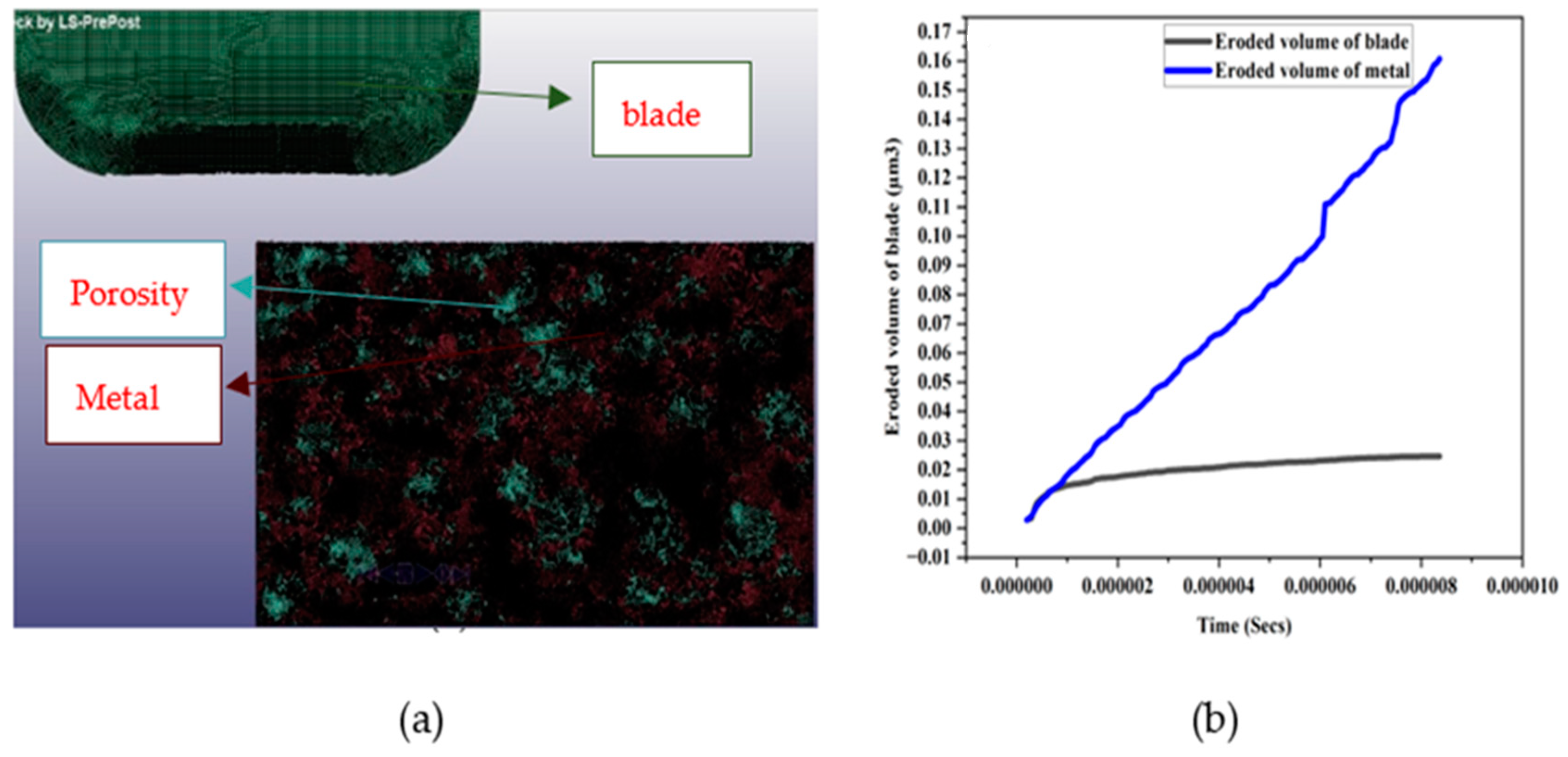
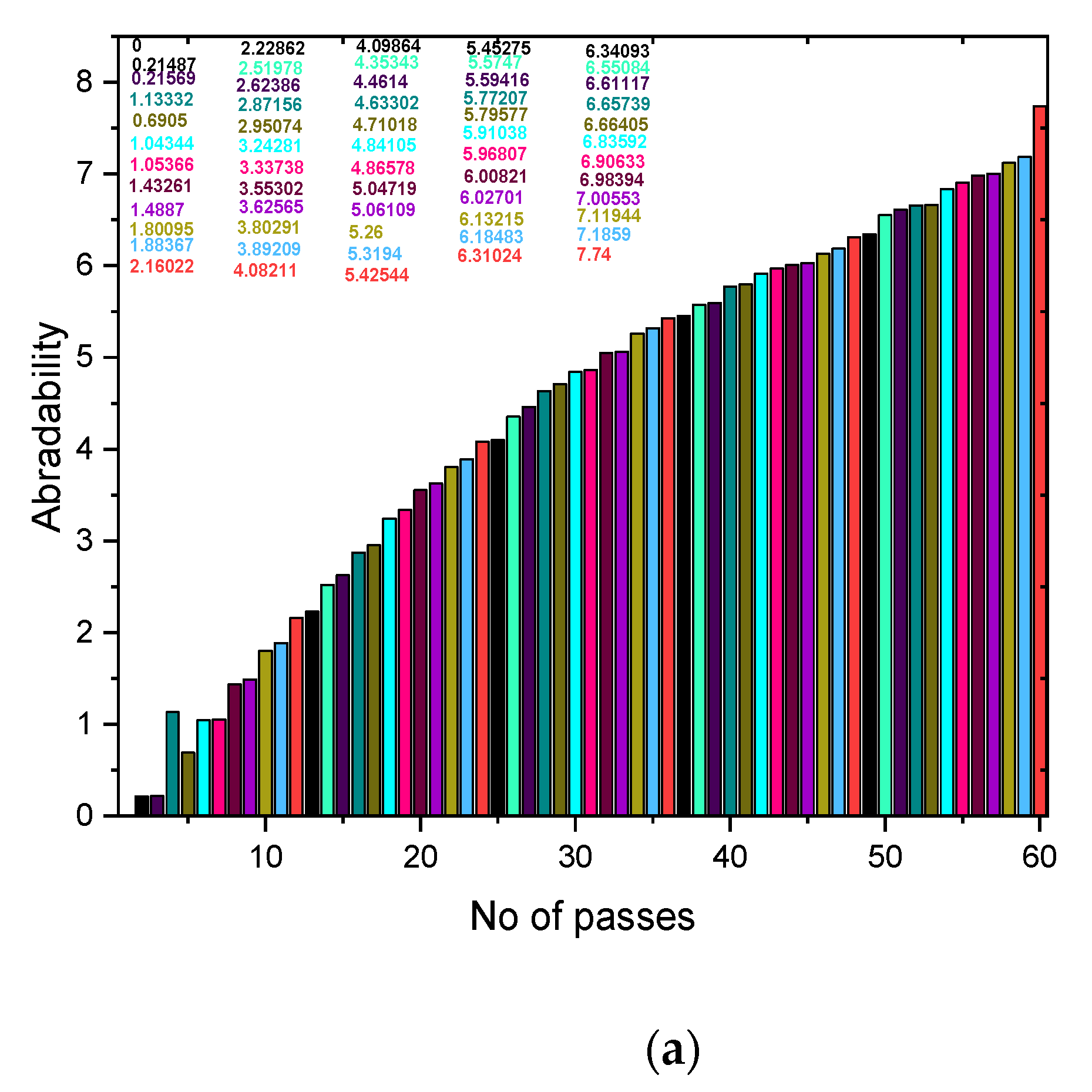
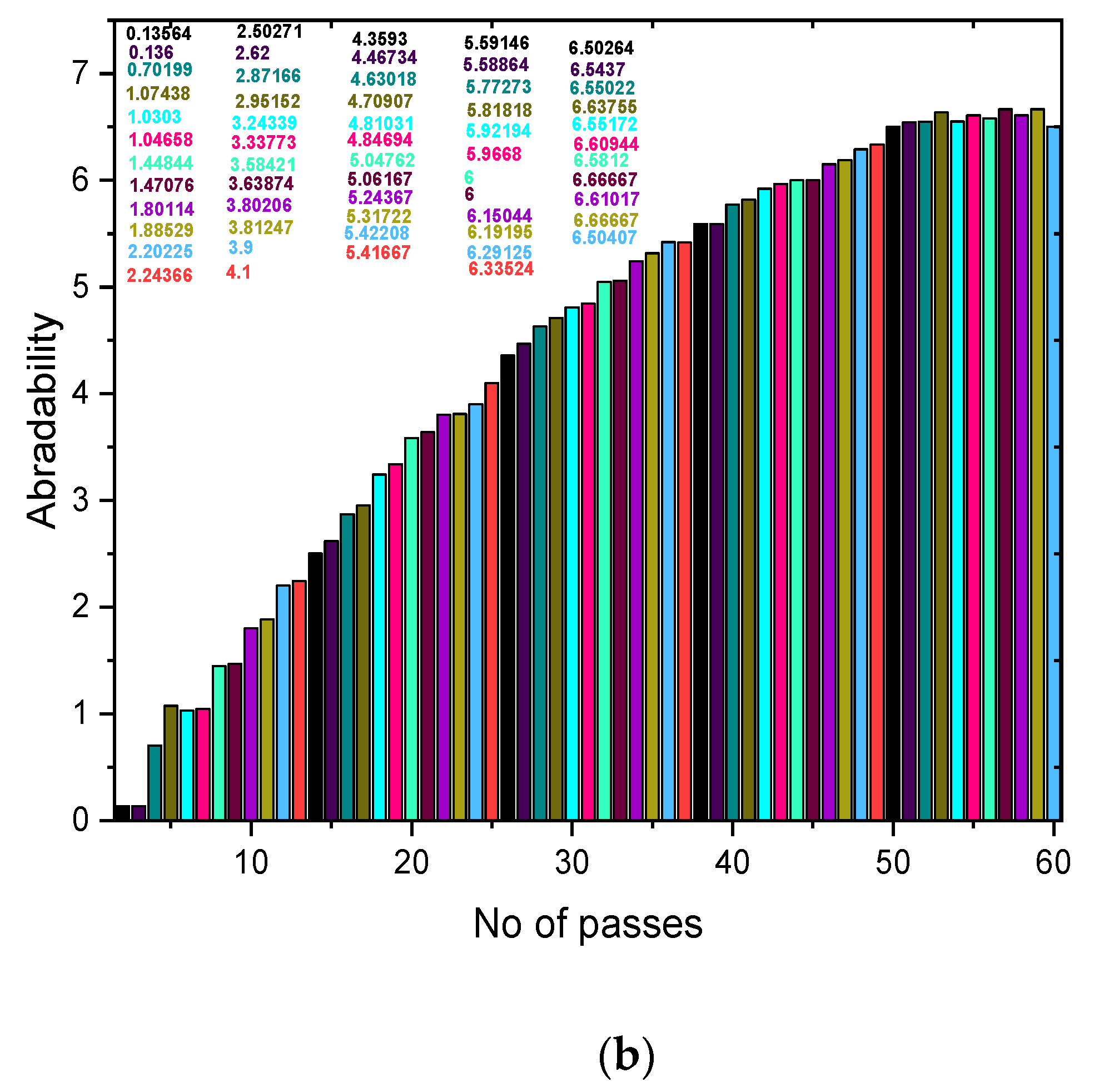

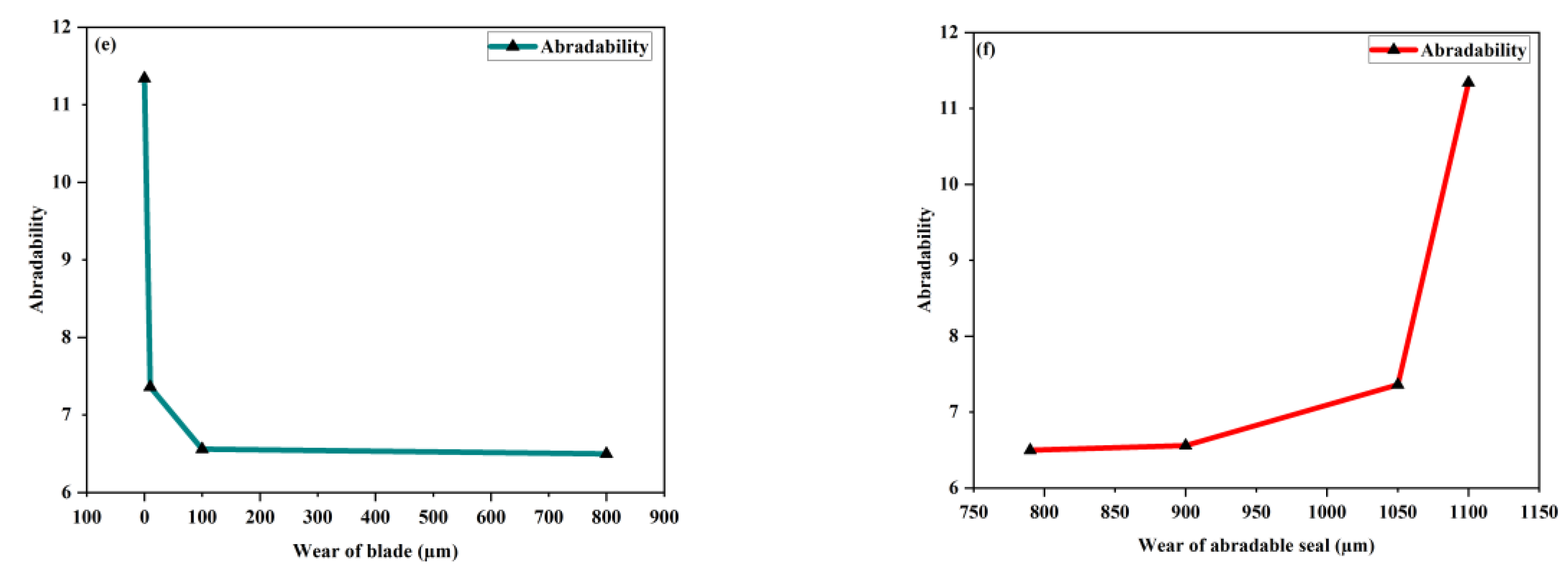
| S. No. | Material | Density (kg/mm3) | Young’s Modulus (Gpa) | Poisson’s Ratio | Yield Strength (Gpa) | Tangent Modulus (Gpa) | Failure Strain |
|---|---|---|---|---|---|---|---|
| 1 | Metal | 3 × 10−6 | 150 | 0.3 | 0.7 | 140 | 0.025 |
| 2 | Porosity | 1 × 10−6 | 1 | 0.33 | 0.025 | 0.1 | 0.02 |
| 3 | Oxide | 3.8 × 10−6 | 190 | 0.34 | 0.375 | 180 | 0.01 |
| 4 | Titanium64 | 3.2 × 10−6 | 159 | 0.342 | - | - | - |
| S. No | Stress (Gpa) | Strain |
|---|---|---|
| 1 | 0 | 0 |
| 2 | 0.17 | 0.02 |
| 3 | 0.2 | 0.05 |
| 4 | 0.21 | 0.1 |
| 5 | 0.22 | 0.25 |
| 6 | 0.18 | 0.5 |
| 7 | 0.125 | 1 |
| Model | Metal Wear (µm3) | Oxide Wear (µm3) | Shroud Wear (Metal + Oxide) (µm3) | Blade Wear (µm3) | Abradability for 60th Pass |
|---|---|---|---|---|---|
| 56% porosity and 48 HR15Y | 1.55 × 10−1 | 1.41 × 10−1 | 2.96 × 10−1 | 2.61 × 10−2 | 11.34 |
| 46% porosity and 71 HR15Y | 1.48 × 10−1 | 2.59 × 10−2 | 1.74 × 10−1 | 2.65 × 10−2 | 6.56 |
| Model | Metal Wear (µm3) | Oxide Wear (µm3) | Shroud Wear (Metal + Oxide) (µm3) | Blade Wear (µm3) | Abradability for 60th Pass |
|---|---|---|---|---|---|
| 50% porosity and 55 HR15Y | 1.78 × 10−1 | 0 | 1.78 × 10−1 | 2.3 × 10−2 | 7.74 |
| 35% porosity and 77 HR15Y | 1.6 × 10−1 | 0 | 1.6 × 10−1 | 2.46 × 10−2 | 6.5 |
| S. No | Property | Case1 | Case2 | Case3 | Case4 |
|---|---|---|---|---|---|
| 1 | Bond strength (Mpa) | 4.8 | 5 | 12.5 | 15 |
| 2 | Erosion rate (µm/sec) | 5.9 | 5.1 | 2.2 | 1.8 |
| 3 | Wear of blade (µm) | 0 | 10 | 100 | 800 |
| 4 | Wear of abradable seal (µm) | 1100 | 1050 | 900 | 790 |
| 5 | Porosity (%) | 56 | 50 | 46 | 35 |
| 6 | Rockwell hardness (HR15Y) | 48 | 55 | 71 | 77 |
| 9 | Abradability | 11.34 | 7.36 | 6.56 | 6.5 |
Disclaimer/Publisher’s Note: The statements, opinions and data contained in all publications are solely those of the individual author(s) and contributor(s) and not of MDPI and/or the editor(s). MDPI and/or the editor(s) disclaim responsibility for any injury to people or property resulting from any ideas, methods, instructions or products referred to in the content. |
© 2023 by the authors. Licensee MDPI, Basel, Switzerland. This article is an open access article distributed under the terms and conditions of the Creative Commons Attribution (CC BY) license (https://creativecommons.org/licenses/by/4.0/).
Share and Cite
Azmeera, A.K.; Jadhav, P.; Lande, C. Microstructure Image-Based Finite Element Methodology to Design Abradable Coatings for Aero Engines. Aerospace 2023, 10, 873. https://doi.org/10.3390/aerospace10100873
Azmeera AK, Jadhav P, Lande C. Microstructure Image-Based Finite Element Methodology to Design Abradable Coatings for Aero Engines. Aerospace. 2023; 10(10):873. https://doi.org/10.3390/aerospace10100873
Chicago/Turabian StyleAzmeera, Anitha Kumari, Prakash Jadhav, and Chhaya Lande. 2023. "Microstructure Image-Based Finite Element Methodology to Design Abradable Coatings for Aero Engines" Aerospace 10, no. 10: 873. https://doi.org/10.3390/aerospace10100873
APA StyleAzmeera, A. K., Jadhav, P., & Lande, C. (2023). Microstructure Image-Based Finite Element Methodology to Design Abradable Coatings for Aero Engines. Aerospace, 10(10), 873. https://doi.org/10.3390/aerospace10100873







